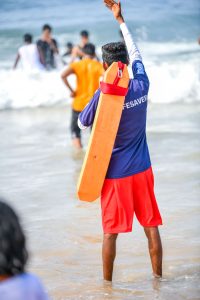
Temperature in Goa has touched record highs this March, amid the Indian Meteorological Department’s (IMD) warning of a heat-wave.
According to the IMD, from March 1 till date, the maximum temperature has shot above 36 degree celsius for a continuous period. The maximum temperature over Goa is likely to remain 4-6 degree celsius above the normal value.
With tourists and locals heading to the beach to get some respite from the heat and cool off in the sea, Drishti Marine, the state-appointed professional lifeguard agency, has issued a summer advisory suggesting simple ways to stay safe while at the beach during the heatwave and the hot summer months to follow.
Drishti’s 450 -strong lifesaving force man Goa’s beaches throughout the year. Owing to the present sea conditions, it is advisable to swim between the flags marked in red and yellow as they indicate moderate surf and currents while strictly avoiding the red flag areas which indicate the non-swim zones.
A beach umbrella is ideal to protect yourself from the sun’s direct heat, keep yourself hydrated by drinking plenty of water. It is advisable to carry sunscreen in order to protect yourselves from sunburns and heat-strokes.

The blue sea is inviting during the sweltering summers. However, the seemingly calm waves may have rip currents, flash currents and underwater currents that the beach goers need to be cautious about before taking a dip into the sea. The team of lifesavers present along the coast are monitoring the surroundings and are trained to carry out rescues in the rough sea conditions.
Navin Awasthi, Operations Head at Drishti Marine says, “The scorching heat also can be the cause of skin rashes, sunburns, and heat strokes. Make sure to stay hydrated throughout the day and try to avoid being in direct sunlight between 12 noon and 3 pm when the rays are the harshest.”
“There are 35 lifesaver towers spread across Goa. In case of any injury, it is best for the beach goers to approach a lifesaver as each lifesaver tower is equipped with a first-aid kit.” adds Navin.
Each morning, lifesavers map the sea currents, changes in wind patterns and underwater activity in order to identify safe swim zones along every beach and mark them with the red and yellow flags. Unsafe zones which are at risk of rip and underwater currents are marked out by red flags, indicating that it is unsafe to swim.






